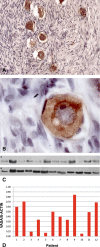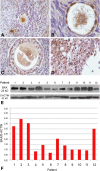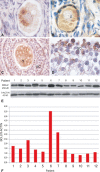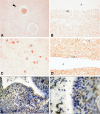The ovarian germinal reserve and apoptosis-related proteins in the infant and adolescent human ovary
- PMID: 30857552
- PMCID: PMC6410530
- DOI: 10.1186/s13048-019-0496-2
The ovarian germinal reserve and apoptosis-related proteins in the infant and adolescent human ovary
Abstract
Background: Normal pubertal ovary displays all stages of follicular development and a biased BAX/BCL2 protein ratio in favor of pro-apoptotic BAX protein comparable to the adult ovary. However, adolescents suffering malignant extra-gonadal disease show a limited follicle development after cytotoxic drug treatment and a reduced capacity of in vitro follicle growth. We evaluated the expression of pro- and anti-apoptotic members of the BCL2 gene family, the FAS/FAS-L proteins from the extrinsic apoptosis pathway, the germ-cell-specific marker VASA, the pluripotency marker OCT3/4, and markers of early and late apoptosis in the ovary of pubertal patients with malignant extra-gonadal disease, which received or not pre-surgery chemotherapy, entering a cryopreservation program.
Results: Ovarian biopsies from 12 adolescent girls were screened for follicle count and expression of VASA, OCT3/4, BAX, BCL2, MCL1L and S, cleaved-BID, FAS/FAS-L and CASPASE 3 through immunohistochemistry, western blot and RT-PCR. All stages of folliculogenesis, from primordial to antral follicle, were present in all 12 patients analyzed. VASA and most of the screened apoptosis-related genes showed a pattern of immune-expression comparable to that previously reported. OCT3/4 showed a cytoplasmic localization in the great majority of the primordial follicles; however, in some cases the localization was nuclear. In addition, OCT3/4B showed a significant reduction compared to OCT3/4A. Unexpectedly, BCL2 was detected at all stages of folliculogenesis, associated to the Balbiani's body in the primordial follicles, regardless of whether patients had or had not received chemotherapy, ruling out the possibility that its expression is a protective response to chemotherapy.
Conclusions: These findings reveal new information on the morphological status of the follicular reserve and the expression of apoptosis-related genes in histologically normal adolescent ovary from patients undergoing extragonadal cancer. The unexpected expression of apoptosis-inhibiting BCL2 protein, both in patients that had or had not received chemotherapy, opens a new avenue for thorough investigations. Moreover, the nuclear localization of OCT3/4 protein in primordial follicle-enclosed oocytes suggests a possible increased activity of ovarian stem cells in response to chemotherapy and/or extragonadal cancer. This new information can be essential for a better managing of in vitro culture of follicles that can be removed by filtration from preserved ovarian tissue, especially in girls that entered a cryopreservation program.
Keywords: Adolescence; Apoptosis; BCL2-family proteins; FAS-FAS-L; Human ovary; OCT3/4; Ovarian reserve; VASA.
Conflict of interest statement
Ethics approval
All procedures performed in this study were approved by the institutional committees from Universidad Maimónides and from Hospital de Niños Ricardo Gutiérrez, Buenos Aires, Argentina. Informed Consent was obtained from all individual participants, and/or their legal representatives, included in this study. The study followed the ethical standards from the 1964 Helsinki declaration and its later amendments.
Consent for publication
Not applicable.
Competing interests
The authors declare that they have no competing interests.
Publisher’s Note
Springer Nature remains neutral with regard to jurisdictional claims in published maps and institutional affiliations.
Figures











References
-
- Albamonte MI, Albamonte MS, Stella I, Zuccardi L, Vitullo AD. The infant and pubertal human ovary: Balbiani’s body associated VASA expression, immunohistochemical detection of apoptosis-related BCL2 and BAX proteins, and DNA fragmentation. Hum Reprod. 2013;28:698–706. doi: 10.1093/humrep/des453. - DOI - PubMed
-
- Albamonte MS, Albamonte MI, Vitullo AD. Germ line apoptosis in the mature human ovary. J Med Res Sci. 2012;2:136–145.
MeSH terms
Substances
LinkOut - more resources
Full Text Sources
Research Materials
Miscellaneous

